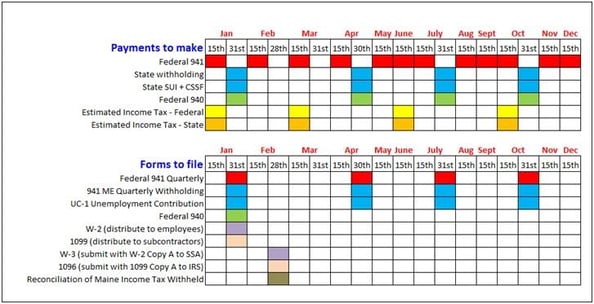Construction Equipment: Should You Buy or Rent?
 The decision to rent or buy equipment for construction work depends on different factors for each business, according to Peter Gregory, Wells Fargo Construction Group Equipment Finance VP. He says that while renting is often a more attractive option in a tough economy when construction activity has slowed down, companies that need and use construction equipment regularly must decide how buying affects their bottom line.
The decision to rent or buy equipment for construction work depends on different factors for each business, according to Peter Gregory, Wells Fargo Construction Group Equipment Finance VP. He says that while renting is often a more attractive option in a tough economy when construction activity has slowed down, companies that need and use construction equipment regularly must decide how buying affects their bottom line.
Advantages of Buying
The advantages of buying the equipment your company needs to perform revenue-generating work include:
 immediate ownership
immediate ownership- deductions for depreciation
- interest to save on taxes
- onsite availability of equipment when work needs to be done
Note that deductions for depreciation are just one tax aspect of buying equipment, and any businesses subject to the Alternative Minimum Tax experience depreciation as a penalty, not a credit.
Thomas Westerkamp of Facilities.net says it makes sense to buy equipment that is just as expensive to rent as to buy, as well as equipment needed immediately in emergency situations to prevent loss or damage, or danger to health and safety, such as emergency generators and portable coolers.
Advantages of Renting
Equipment such as a scissor lift that might be used on a rare occasion would be wise to rent, allowing you to reallocate money towards buying equipment used more often on job sites. This way, the cost of maintenance is eliminated while the use of the equipment is still available. Renting is also advised when trying out new equipment and deciding if it's versatile, useful, and efficient for owning in the future.
How to Decide
One alternative to consider is to purchase quality used equipment which can bring the purchase price down from a new unit, while still providing the same capabilities and convenience of owning. But in this case, buyers beware! Check all safety equipment with the purchase, inspect it closely, and check all manuals and accessories to ensure it's in good condition for your purpose.
Other considerations when deciding to rent or buy include:

- Was the unit previously used as a rental?
- What are all the costs, initial and ongoing, of the rental or purchase?
- What agreements or contracts are part of the deal (purchase or rental) and what is included in them as far as dealer references, equipment demonstration, operator training, and terms of use and return?
- If you buy, will it eventually pay for itself when you consider the time saved and renting fees?
- Does the machine show signs of having been repaired? If so, what is the quality of the repair?
The decision about buying or renting really depends on unique business factors at individual companies. Mid Country Machinery owner Lucas Peed advises that the decision to buy or rent has a lot to do with the type of contractor business. He says local contractors are more likely to buy equipment to get the tax breaks and equity, while general contractors who travel a lot are more likely to rent equipment rather than haul it out of state for jobs, which adds to the cost of operation and ownership. Discuss your potential investment with your accountant and be thoughtful of the longevity of your potential purchase. If it will be an asset to your business for years to come, continue to bring new business, and improve the efficiency of your work, it is a wise investment.
 Guest Blogger: Heidi Cardenas is a freelance writer with a background in human resources, business administration, technical writing and corporate communications. She specializes in human resources, business and personal finance, small-business advice and home improvement. She enjoys creating informational content for clients including blog posts, articles, white papers, case studies, and talking points, as well as business documents such as sales letters, business plans and strategic plans.
Guest Blogger: Heidi Cardenas is a freelance writer with a background in human resources, business administration, technical writing and corporate communications. She specializes in human resources, business and personal finance, small-business advice and home improvement. She enjoys creating informational content for clients including blog posts, articles, white papers, case studies, and talking points, as well as business documents such as sales letters, business plans and strategic plans.
 Payroll is complicated enough without having to worry about when to make payments and when to file which form to which government entity. I have many clients who are comfortable creating paychecks, but are nervous about missing payroll tax payments or filing forms late. A client recently asked if I couldn’t find a simple way to have reminders that would prompt him to do whatever had to be done. To help I created a simple “in your face” payroll reminder.
Payroll is complicated enough without having to worry about when to make payments and when to file which form to which government entity. I have many clients who are comfortable creating paychecks, but are nervous about missing payroll tax payments or filing forms late. A client recently asked if I couldn’t find a simple way to have reminders that would prompt him to do whatever had to be done. To help I created a simple “in your face” payroll reminder.
 How to get it on your desktop
How to get it on your desktop


 The information you include in your proposal comes from your many years of experience and education. For this you deserve to be compensated. I would also suggest your proposal probably only contains a level of detail adequate for you and your team to build from. In reality your proposal may not have adequate detail for others to build from. This may be the best reason to explain to your prospect why you won’t leave it with them unless they buy from you.
The information you include in your proposal comes from your many years of experience and education. For this you deserve to be compensated. I would also suggest your proposal probably only contains a level of detail adequate for you and your team to build from. In reality your proposal may not have adequate detail for others to build from. This may be the best reason to explain to your prospect why you won’t leave it with them unless they buy from you. I also suggest you consider the possible liability you take on by creating specifications, in particular project plans, and leaving them with a prospect that does not do business with you. By doing so you may have put yourself into a position where the prospect or another contractor actually works from them. If they have challenges when building the project and decide those challenges were caused by your plans and or specs, they may have legal rights to sue you. Even if they technically don’t have legal grounds, what if they do sue you? Regardless of whether you feel you are innocent or guilty, you will need to cover your own legal expenses if you end up in court. Most likely you will not be able to re-coup your legal costs even if you are found innocent. If you are found guilty you may actually be required to pay the legal expenses incurred by the person suing you.
I also suggest you consider the possible liability you take on by creating specifications, in particular project plans, and leaving them with a prospect that does not do business with you. By doing so you may have put yourself into a position where the prospect or another contractor actually works from them. If they have challenges when building the project and decide those challenges were caused by your plans and or specs, they may have legal rights to sue you. Even if they technically don’t have legal grounds, what if they do sue you? Regardless of whether you feel you are innocent or guilty, you will need to cover your own legal expenses if you end up in court. Most likely you will not be able to re-coup your legal costs even if you are found innocent. If you are found guilty you may actually be required to pay the legal expenses incurred by the person suing you. Dealing with customers, subs and employees isn't always easy. All too often they can say and do things to us that can really strike a nerve. How you react in the situation can really make a statement about your professionalism as well as what they might actually share with others about your reactions.
Dealing with customers, subs and employees isn't always easy. All too often they can say and do things to us that can really strike a nerve. How you react in the situation can really make a statement about your professionalism as well as what they might actually share with others about your reactions. Now consider this example. If you asked a prospective lead carpenter you are considering hiring how he or she deals with stress or frustration on the job and they share that beating the snot out of a wood scrap with their 28 oz Estwing works best, would you hire him or her? I certainly wouldn't.
Now consider this example. If you asked a prospective lead carpenter you are considering hiring how he or she deals with stress or frustration on the job and they share that beating the snot out of a wood scrap with their 28 oz Estwing works best, would you hire him or her? I certainly wouldn't.
 I often hear contractors say they offer fair pricing. When I ask them what they mean by that most really can't provide a logical answer, or their answer is subjective. It got me to thinking about what fair pricing really is. I came up with three considerations I think make a contractor's pricing fair to their customers, but also to their business as well as their employees. Let me know what you think.
I often hear contractors say they offer fair pricing. When I ask them what they mean by that most really can't provide a logical answer, or their answer is subjective. It got me to thinking about what fair pricing really is. I came up with three considerations I think make a contractor's pricing fair to their customers, but also to their business as well as their employees. Let me know what you think. I would suspect most contractors work for customers who have good jobs offering decent pay for the job performed, workers compensation coverage, benefits like vacation and holiday pay so they can enjoy life, health insurance so they can stay healthy and retirement contributions so they can save for a comfortable retirement. I bet if their employers took any of those things away from them “it wouldn’t be fair”.
I would suspect most contractors work for customers who have good jobs offering decent pay for the job performed, workers compensation coverage, benefits like vacation and holiday pay so they can enjoy life, health insurance so they can stay healthy and retirement contributions so they can save for a comfortable retirement. I bet if their employers took any of those things away from them “it wouldn’t be fair”.
 Don’t you just hate it when a prospect you expected to do business with gives your detailed plans and or specifications to another contractor? That’s bad enough, but isn’t even worse when they give the job to the other contractor and that guy would never have been able to offer the work or price the job without your specs?
Don’t you just hate it when a prospect you expected to do business with gives your detailed plans and or specifications to another contractor? That’s bad enough, but isn’t even worse when they give the job to the other contractor and that guy would never have been able to offer the work or price the job without your specs?  “Will you need help discussing and specifying the details and products to be used in your project in order to make good decisions about your project and how much money to invest in it?”
“Will you need help discussing and specifying the details and products to be used in your project in order to make good decisions about your project and how much money to invest in it?”  Here is some sample language you can consider using inside the remodeling proposals you create for prospects. This information is for your reference only. Be sure you have it reviewed by your own legal council before using it.
Here is some sample language you can consider using inside the remodeling proposals you create for prospects. This information is for your reference only. Be sure you have it reviewed by your own legal council before using it. 
 This investor buyer will need a leader/manager to run the company. Before offering your business for sale to this buyer type I suggest you transfer the leadership and the day to day management of your business to a well qualified employee over a period of time. During the evolution you can test and prove his/her effectiveness as a general manager in advance of selling. By taking adequate time to accomplish this important consideration at my business both me and my employees felt good about and respected the new leader, before I fully transitioned out of the day to day.
This investor buyer will need a leader/manager to run the company. Before offering your business for sale to this buyer type I suggest you transfer the leadership and the day to day management of your business to a well qualified employee over a period of time. During the evolution you can test and prove his/her effectiveness as a general manager in advance of selling. By taking adequate time to accomplish this important consideration at my business both me and my employees felt good about and respected the new leader, before I fully transitioned out of the day to day. Having systems and employees in place will be important, but you might want to assume that this buyer will likely change or evolve the systems you have put in place. As a result the employees described above might not like and/or agree with the changes. In particular experienced management employees may not tolerate any loss of the independence they have already earned in performing their day to day roles. If you plan to sell to this type of a buyer, I suggest you assemble employees who desire to follow a leader and will go with the flow.
Having systems and employees in place will be important, but you might want to assume that this buyer will likely change or evolve the systems you have put in place. As a result the employees described above might not like and/or agree with the changes. In particular experienced management employees may not tolerate any loss of the independence they have already earned in performing their day to day roles. If you plan to sell to this type of a buyer, I suggest you assemble employees who desire to follow a leader and will go with the flow.  Since selling my remodeling business in 2004, many remodelers have asked me for help and insight about how I did it and how they too could sell their businesses some day. They ask great questions. The challenge is that there is no easy one size fits all answer. In this article I will share a few big picture considerations to help guide you. In a follow up article I will discuss typical buyer types you can consider as possible prospects to sell to.
Since selling my remodeling business in 2004, many remodelers have asked me for help and insight about how I did it and how they too could sell their businesses some day. They ask great questions. The challenge is that there is no easy one size fits all answer. In this article I will share a few big picture considerations to help guide you. In a follow up article I will discuss typical buyer types you can consider as possible prospects to sell to.
 If you’re considering selling your business some day you will need to consider the types of buyers out there as well as their typical motivations for buying one business versus another. In my next blog I will discuss the two typical buyer types you will want to consider as you make you plan and write your for sale ad.
If you’re considering selling your business some day you will need to consider the types of buyers out there as well as their typical motivations for buying one business versus another. In my next blog I will discuss the two typical buyer types you will want to consider as you make you plan and write your for sale ad. The decision to rent or buy equipment for construction work depends on different factors for each business, according to Peter Gregory, Wells Fargo Construction Group Equipment Finance VP. He says that while renting is often a more attractive option in a tough economy when construction activity has slowed down, companies that need and use construction equipment regularly must decide how buying affects their bottom line.
The decision to rent or buy equipment for construction work depends on different factors for each business, according to Peter Gregory, Wells Fargo Construction Group Equipment Finance VP. He says that while renting is often a more attractive option in a tough economy when construction activity has slowed down, companies that need and use construction equipment regularly must decide how buying affects their bottom line. immediate ownership
immediate ownership
 Guest Blogger: Heidi Cardenas is a freelance writer with a background in human resources, business administration, technical writing and corporate communications. She specializes in human resources, business and personal finance, small-business advice and home improvement. She enjoys creating informational content for clients including blog posts, articles, white papers, case studies, and talking points, as well as business documents such as sales letters, business plans and strategic plans.
Guest Blogger: Heidi Cardenas is a freelance writer with a background in human resources, business administration, technical writing and corporate communications. She specializes in human resources, business and personal finance, small-business advice and home improvement. She enjoys creating informational content for clients including blog posts, articles, white papers, case studies, and talking points, as well as business documents such as sales letters, business plans and strategic plans. With a well thought out strategy for offering design services contractors can differentiate their businesses and attract better quality clients and projects. However if their offering is not well thought out contractors can lose a lot of money and waste a lot of time.
With a well thought out strategy for offering design services contractors can differentiate their businesses and attract better quality clients and projects. However if their offering is not well thought out contractors can lose a lot of money and waste a lot of time. 

 #4: Use a supporting marketing and sales strategy
#4: Use a supporting marketing and sales strategy Choosing your MA CSL renewal class simply by price or location may not be a good investment for some MA CSL license holders. Sure, you may get the credits you need, but why not also seek to increase the return on investment of your hard earned money!
Choosing your MA CSL renewal class simply by price or location may not be a good investment for some MA CSL license holders. Sure, you may get the credits you need, but why not also seek to increase the return on investment of your hard earned money!
 The first is whether the class instructor is experienced as a teacher and can effectively help you and or your employees learn the topic at hand. Some trainers have degrees in education and lots of previous experience actually teaching. Other trainers lack the skills and or experience needed to help you actually understand and then apply what you learn in class in the real world. I suggest you choose a trainer with a proven educational background. If you don’t already have past experience with the trainer and his/her abilities, referrals and or testimonials from past attendees can be a big help when making your selection.
The first is whether the class instructor is experienced as a teacher and can effectively help you and or your employees learn the topic at hand. Some trainers have degrees in education and lots of previous experience actually teaching. Other trainers lack the skills and or experience needed to help you actually understand and then apply what you learn in class in the real world. I suggest you choose a trainer with a proven educational background. If you don’t already have past experience with the trainer and his/her abilities, referrals and or testimonials from past attendees can be a big help when making your selection.





